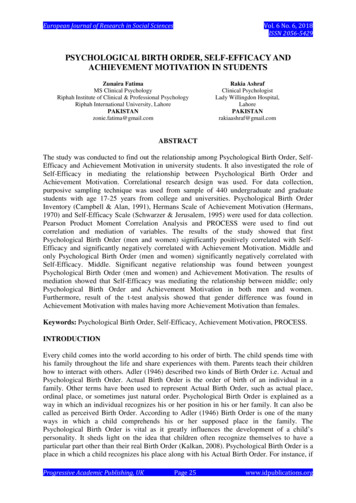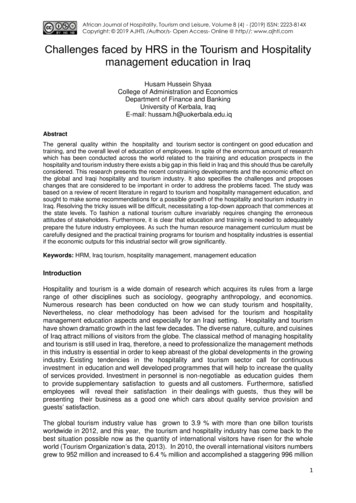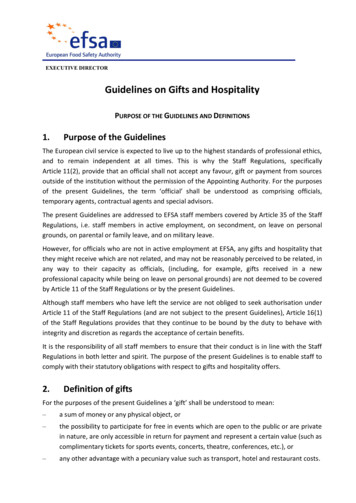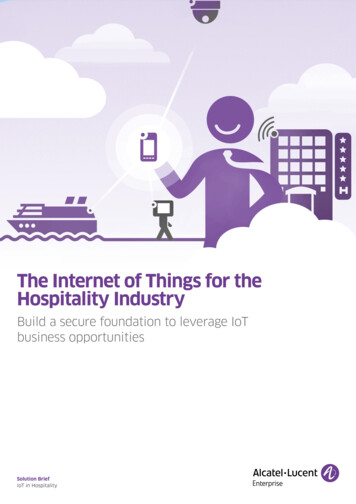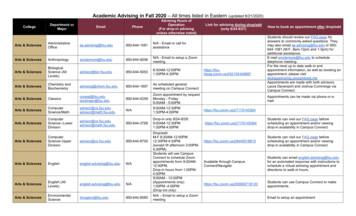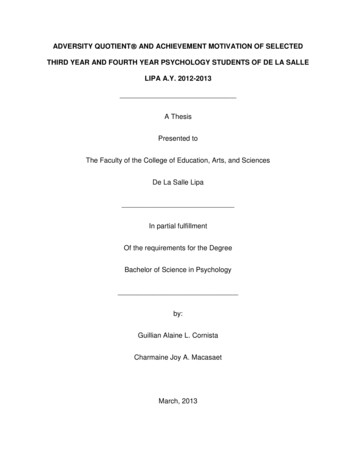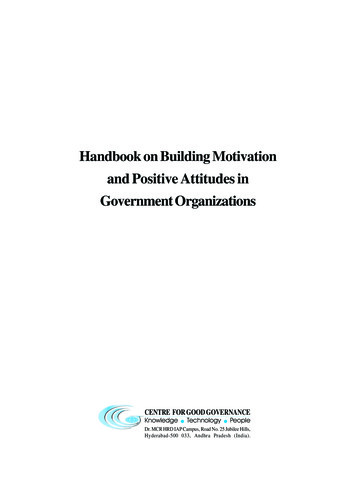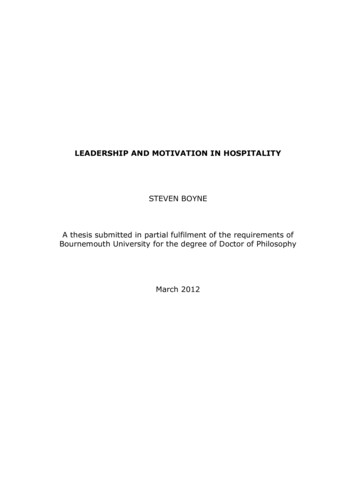
Transcription
LEADERSHIP AND MOTIVATION IN HOSPITALITYSTEVEN BOYNEA thesis submitted in partial fulfilment of the requirements ofBournemouth University for the degree of Doctor of PhilosophyMarch 20121
2
This copy of the thesis has been supplied on condition thatanyone who consults it is understood to recognise that itscopyright rests with its author and due acknowledgementmust always be made of the use of any material contained in,or derived from, this thesis.3
2
ABSTRACTSteven BoyneLeadership and motivation in hospitalityCustomer contact service employees in hospitality organisations have acritical role to play in satisfying customers’ expectations. However, it isrecognised that hospitality service jobs are often associated with low pay,long and anti-social hours, unstable and seasonal employment, low job status,a lack of career opportunities and poor levels of benefits. In the light offactors such as these, which are likely to militate against high levels ofmotivation - and consequently to reduce the quality of customer service addressing hospitality customer service employees’ motivation can be viewedas a priority for hospitality management.Inspirational, motivational leaders can motivate employees to ‘performbeyond expectations’ and previous studies of leadership in hospitality havedemonstrated a number of positive outcomes related to the presence ofinspirational leaders. No studies have been identified, however, that havemeasured the specific influence of motivational leadership on hospitalityservice employees’ job performance.To evaluate the contribution of motivational leadership to employee workmotivation, work motivation was measured using both employee attitudes andjob performance. Data were collected from a sample of non-supervisorywaiting staff in hotel businesses in the UK. In total, two hundred and thirteenusable survey forms were returned from twenty seven UK hotels with tableservice restaurants. All of the participating organisations were rated as threeor four stars and the mean number of non-supervisory waiting staff in thesehotels was twenty three.The study finds that motivational leadership, alongside employee perceptionsof empowerment and employees’ work orientations, contributes positively toboth work attitudes and job performance.The research also finds that motivational leadership enhances employees’work meaning and understanding of organisational goals (mission clarity).In addition to its empirical dimensions, the research contributes to hospitalitystudies theory by critically appraising the leadership-related hospitalityliterature and making recommendations for the future progress of hospitalityleadership studies.3
List of Contents12INTRODUCTION. 171.1Background and rationale . 171.2Aims, objectives and research design . 191.3Structure of the thesis . 22LEADERSHIP . 242.1Definitions of leadership . 242.2Reviewing the reviews: complexity and contestation in leadershipstudies . 272.2.12.3Summary of paradigmatic progression in leadership studies . 31Major theories of leadership . 332.3.1Trait theories . 332.3.2Behavioural theories . 342.3.3Situational or contingency approaches . 402.3.4Relational theory: Leader-Member Exchange (LMX) . 472.3.5Antonakis et al.’s Schools: Skeptics, Information-Processing,Contextual and New Leadership . 482.4Transformational leadership . 502.4.1Origins and essence. 502.4.2Transformational leadership in organisations . 512.4.3The evolution of transformational leadership theory fororganisations . 522.4.43Transformational leadership outcomes . 58LEADERSHIP IN HOSPITALITY . 613.1Review strategy and analytical framework . 613.2Early research (1970s) . 653.3Behavioural theory work . 663.3.1Initiating structure / consideration focused studies . 683.3.2Leadership competencies approaches . 693.3.3Implicit leadership theory (ILT) approaches . 713.4Contingency theory work . 733.5Leader-Member Exchange (LMX) theory work . 743.6Transformational leadership theory work . 763.6.1Transformational leadership in hospitality: rationales andoutcomes . 793.7Miscellaneous studies . 823.8Summary of hospitality leadership findings . 843.9Leadership in hospitality: the state of the art . 853.10Evolution of leadership studies in hospitality . 873.11Pittaway et al.’s (1998) paradigmatic framework . 893.11.1Pittaway et al.’s paradigms: a critique . 913.11.2The trouble with the taxonomy . 933.12Reconceptualising the research agenda . 974
4DEVELOPING THE THEORETICAL FRAMEWORK . 1014.1Work motivation research . 1034.1.14.2I/O Psychology and Organisational Behaviour . 1104.3Motivation research in hospitality studies . 1174.3.14.45Making sense of work motivation . 109Core articles from Simons’ review . 119Exposition of the latent variables and hypotheses . 125MEASURING THE LATENT VARIABLES . 1305.1Dispositional factors / individual values . 1315.2Interpersonal, group and organisational processes. 1355.3Primary organisational outcomes: employee attitudes . 1465.4Secondary organisational outcomes: individual, group andorganisational outcomes . 1595.56Summary of Chapters 4 and 5. 168METHODS FOR DATA COLLECTION AND ANALYSIS . 1706.1Structural equation modelling . 1706.2Modelling approach . 1736.3Data assumptions and software . 1746.4Modelling strategy . 1766.4.16.5Instrumentation . 1796.5.1Questionnaire design and refinements . 1806.5.2Administration of the full survey . 1886.67Building the models . 178Data screening . 1976.6.1Treatment of missing data . 1976.6.2Distributional normality . 206ANALYSIS . 2087.1Re-statement of the analytical framework . 2087.2Model 1, Step 1: the measurement model . 2087.2.1Measurement model specification . 2097.2.2Measurement model identification . 2107.2.3Measurement model estimation . 2127.2.4Measurement model testing . 2127.2.5Assessment of construct validity. 2137.2.6Assessment of model fit . 2177.2.7Testing the measurement model (CFA 1:1) . 2217.2.8Measurement model modification . 2237.2.9Measurement model: first respecification (CFA 1:2) . 2277.2.10Measurement model: second respecification (CFA 1:3) . 2287.3Model 1, Step 2: the structural model . 2307.4Model 2 . 2347.5Model 3 . 2427.6Model 3b . 2485
7.6.1Model 3 / Model 3b summary . 2597.7Model 4 . 2617.8Model 5 . 2677.9Model 5b . 2777.9.1Employee attitudes and discretionary service behaviour . 2847.9.2Model 5 / Model 5b summary . 2867.10Model 6 . 2867.11Model 7 . 2877.12Post-development validation of the model . 2887.13Post-modification construct identities . 2947.14Construct relationships and effect sizes . 2987.15Multi-group analyses. 3027.15.1Demographic variables . 3037.15.2Supervisor contact, training and information . 3077.15.3Work values . 3087.15.4Summary of multi-group moderator analyses . 3117.168Model 8: Mission Clarity . 312REVIEW, DISCUSSION AND CONCLUSION . 3148.1Précis of the research . 3148.2The model development process . 3198.2.18.3Additional analyses . 328Contributions, new conceptualisations and areas for further research . 3348.3.1Work motivation: behavioural measures . 3378.3.2Work motivation: attitudinal measures . 3418.3.3Work Values . 3468.3.4Motivational leadership . 3488.3.5Employee Empowerment . 3488.3.6Limitations of the current study . 3528.3.7Implications of the data collection outcomes for the researchfindings . 3558.3.88.49Other areas for further research . 357Conclusions . 357LIST OF REFERENCES . 36010APPENDICES . 39310.1Appendix I: Complete list of hypotheses following modeldevelopments . 39310.2Appendix II: Univariate normality for all item scale variables . 39410.3Appendix III: SEM estimates and matrices . 39610.4Appendix IV: Bootstrap estimates and distributional normality . 40310.5Appendix V: Hospitality leadership literature . 41110.6Appendix VI: The pre-test survey form . 41310.7Appendix VII: The pilot survey form . 42010.8Appendix VIII: The full survey form . 4246
List of FiguresFigure 2-1 Van Seters and Field’s Evolutionary Tree .29Figure 2-2 Situational Favourability in the LPC Contingency Model .41Figure 2-3 The full range model of transformational leadership .54Figure 2-4 The augmentation model of transactional and transformationalleadership .54Figure 3-1 Summary of hospitality leadership LMX research findings .76Figure 3-2 Summary of Pittaway et al.’s paradigms .91Figure 3-3 Hospitality leadership studies categorised according to Pittaway etal.’s framework .94Figure 4-1 Example of a variable as both dependent and independent . 112Figure 4-2 Organising framework for the identified factors . 113Figure 4-3 Organising framework with hypothesised causal links . 114Figure 4-4 Latent variables identified from the reviews of literature . 125Figure 4-5 Organising framework including the DSB construct . 126Figure 5-1 The source of the Work Values indicator variables . 133Figure 5-2 The Work Values construct . 134Figure 5-3 The Motivational Leadership construct. 137Figure 5-4 The Empowerment construct . 141Figure 5-5 The Social Support construct . 145Figure 5-6 The Job Satisfaction construct . 149Figure 5-7 Wollack et al.’s domains and constructs . 153Figure 5-8 The Work Meaning construct . 154Figure 5-9 The Affective Organisational Commitment construct . 159Figure 5-10 The Job Performance construct . 161Figure 5-11 The Discretionary Service Behaviour construct . 162Figure 5-12 Analysis of Bitner et al.’s customer/employee data . 165Figure 5-13 The Service Quality construct . 167Figure 6-1 Example structural equation model . 171Figure 7-1 Organising framework including the DSB construct . 208Figure 7-2 Specification for the measurement model CFA 1:1 . 210Figure 7-3 Summary of acceptable threshold levels . 221Figure 7-4 The structural model specification SEM 1:1 . 231Figure 7-5 Estimates for SEM 1:1 . 231Figure 7-6 Structural specification for Model 2 . 234Figure 7-7 Estimates for SEM 2:1 . 239Figure 7-8 Constrained model SEM 2:1b . 240Figure 7-9 Constrained model SEM 2:1c . 241Figure 7-10 Structural specification for Model 3 . 243Figure 7-11 Structural specification for Model 3b . 248Figure 7-12 Interpretations for the Employee Attitudes construct . 255Figure 7-13 Wollack et al.’s Work Meaning domains . 256Figure 7-14 Parameter estimates and model fit for SEM 3b . 2587
Figure 7-15 The original Model 3 specification . 259Figure 7-16 Model 3b structure, estimates and fit statistics . 260Figure 7-17 Structural specification for Model 4 . 262Figure 7-18 Estimates for Model 4 (SEM 4:2) . 265Figure 7-19 Structural specification for Model 5 . 268Figure 7-20 Estimates and model fit for SEM 5:2 . 272Figure 7-21 Structural specification for Model 5b . 277Figure 7-22 Estimates and model fit for SEM 5b:2 . 280Figure 7-23 SEM 5b:3 with the EPA DSB path . 285Figure 7-24 Summary of modified construct definitions . 298Figure 7-25 Contact, training and information statements . 307Figure 7-26 Distribution of the Work Values summated scale variable . 310Figure 7-27 Estimates for Model 8: Mission Clarity . 313Figure 8-1 Organising framework for the research . 318Figure 8-2 Model 2. 321Figure 8-3 Model 3b . 323Figure 8-4 Model 5b . 325Figure 8-5 Job Satisfaction predicting Job Performance . 3318
List of tablesTable 2-1 Mintzberg’s Management Roles .25Table 2-2 Thematic reviews of leadership studies.28Table 2-3 Antonakis et al.’s Major schools of leadership .30Table 2-4 Common themes and problem areas .31Table 2-5 Production- and employee-centred leadership orientation in varioustheoretical contexts .36Table 2-6 Situational variables within potential significance for catering serverperformance .46Table 2-7 Bass’s (1985) major factors of transformational leadership .52Table 2-8 The Idealized Influence Factor .56Table 3-1 Primary theoretical foci of leadership in hospitality papers .63Table 3-2 Summary of hospitality leadership studies by primary theoreticalfocus .64Table 3-3 Miscellaneous behavioural approach studies .67Table 3-4 Leadership-competencies approaches .70Table 3-5 Implicit leadership theory (ILT) approaches .72Table 3-6 Transformational leadership hospitality studies: foci and findings .77Table 3-7 Leadership outcomes measured in the (empirical) hospitality studiesutilising transformational leadership .79Table 3-8 Rationales for employing transformational leadership .81Table 4-1 Research hypotheses derived from the literature reviews of genericand hospitality-specific leadership research . 115Table 4-2 Description and background for the research hypotheses . 127Table 4-3 Description and background for the Service Quality hypotheses . 128Table 5-1 Hospitality studies employing Organisational Commitment. 156Table 5-2 Allen and Meyer’s (1990) Affective Commitment scale . 158Table 6-1 Descriptive statistics for the sample . 195Table 6-2 Comparison of sample characteristics with known population values. 196Table 6-3 Distribution of missing values by variable . 203Table 6-4 Distribution of missing values by case . 204Table 7-1 Estimates for the measurement model CFA 1:1 . 222Table 7-2 Factor correlations and squared correlation estimates for the initiallyspecified measurement model (CFA 1:1) . 224Table 7-3 Discriminant validity estimates for CFA 1:1 . 224Table 7-4 Modifications made to the initially specified measurement model(CFA 1:1) . 226Table 7-5 Estimates for CFA 1:2 . 227Table 7-6 Estimates for CFA 1:3 . 228Table 7-7 Correlation estimates for CFA 1:3 . 229Table 7-8 Discriminant validity estimates for CFA 1:3 . 229Table 7-9 Estimates for CFA 2:1 . 2359
Table 7-10 Modifications to CFA 2:1 . 236Table 7-11 Estimates for CFA 2:2 . 237Table 7-12 Estimates for CFA 2:3 . 238Table 7-13 Total (standardised) effects for Model 2 . 241Table 7-14 Estimates for CFA 3:1 . 244Table 7-15 Estimates for CFA 3:2 . 245Table 7-16 Estimates for CFA 3:3 . 246Table 7-17 Estimates for CFA 3:4 . 247Table 7-18 Estimates for CFA 3b:1 . 249Table 7-19 Estimates for CFA 3b:8 . 254Table 7-20 Discriminant validity estimates for CFA3b:8 . 254Table 7-21 Total (standardised) effects for Model 3b . 260Table 7-22 Modification steps for CFA 4:1 to 4:7 . 263Table 7-23 Estimates and construct validity for the final measurement modelspecification CFA 4:7. 264Table 7-24 Total (standardised) effects for Model 4 . 267Table 7-25 Modification steps for CFA 5:1 to 5:7 . 269Table 7-26 Estimates and model fit for CFA 5:7 . 270Table 7-27 Chi square difference test for SEM 5:1 and SEM 5:11 . 276Table 7-28 Modification steps for CFA 5b:1 to 5b:8 . 278Table 7-29 Estimates and model fit for CFA 5b:8 . 279Table 7-30 Total (standardised) effects for Model 5b . 282Table 7-31 Comparison of Models 5 and 5b . 283Table 7-32 Post-development comparisons for Model 5b . 289Table 7-33 Model fit for the baseline and constrained models . 292Table 7-34 Chi-square difference tests for Model 5b validation . 293Table 7-35 Research hypotheses and research findings . 299Table 7-36 Sample demographics comparison with known population values. 303Table 7-37 Distribution of the respondent characteristics data . 304Table 7-38 Moderator analysis for Model 2 . 305Table 7-39 Moderator analysis for Model 5b . 306Table 7-40 Group distributions for work characteristic categories . 308Table 7-41 Distribution of the Work Values reduced and recoded summatedscale variable . 310Table 7-42 Summary of findings from moderator analyses . 311Table 8-1 Summary of hypotheses tested and effect sizes . 336Table 8-2 Comparison of DSB factor loadings with Simons and Roberson(2003) . 340Table 8-3 Servant and transformational leadership compared . 351Table 8-4 Effects of data collection outcomes on the research findings . 35610
ACKNOWLEDGEMENTSThanks are due firstly to my wife, Caroline, for encouraging (and supporting!)this venture. Further encouragement and support has also been forthcomingfrom my parents, Evelyn and John, and from my wife’s parents, Graham andBarbara.At Bournemouth University, my supervisory team, Adam (Blake) and Peter(Lugosi), have each provided excellent insight and guidance, and thanks mustalso go to Dr Jonathan Edwards of the School of Tourism for liaising betweenmyself and the School during the scholarship application process.Acknowledgement is due, of course, to Bournemouth University and theSchool of Tourism for providing the scholarship to undertake this research.A number of organisations and individuals provided assistance with the datacollection process. Many of these are hotel general managers who remainanonymous here for reasons of confidentiality. Individuals not associatedwith specific commercial businesses and to whom thanks are due are: AlanCutler (Hospitality Leadership Ltd), Mark Maltby (Hospitality Skills Academy),Stella Callaghan (VisitScotland), Graeme Gibson (Greater Glasgow HotelAssociation), Alastair Galbraith (People 1st), Stephen Williamson, GillianSwanney and Margaret McNeil (Scottish Enterprise), Colin Paton (EdinburghHotels Association) and Rosie McReadie (Skills Development Scotland).Thanks are also due to the respondents who took the time to complete thesurvey forms.This thesis is dedicated to our wonderful daughters, Lowena and Iona, whoarrived just as the final edits were being made.11
DECLARATIONFigure 2-1 from Van Seters and Field (1990: 33) is reproduced withpermission from Emerald Group Publishing Ltd.12
Commonly used abbreviationsGeneralTLTransformational leadershipMLQMulti-factor Leadership QuestionnaireFRLMFull-Range Leadership ModelLMXLeader-Member-ExchangeThe constructsWVWork ValuesEMEmployee EmpowermentMLMotivational LeadershipMEWork MeaningJSJob SatisfactionAOCAffective Organisational CommitmentSSSocial SupportJPJob PerformanceDSBDiscretionary Service BehaviourSQService QualityStatisticsSEM2Structural Equation ModellingχChi SquareCFIComparative Fit IndexRMSEARoot Mean Square Error of ApproximationSRMRStandardised Root Mean ResidualPNFIParsimony Normed Fit IndexCN(Hoelter’s) Critical NCRMultivariate kurtosis critical ratio. Equivalent to Mardia’s(1970) normalised estimate of multivariate kurtosisd.f.Degrees of FreedomSRCStandardised Residual CovarianceSRCMStandardised Residual Covariance MatrixMIModification Index13
11.1INTRODUCTIONBackground and rationaleThe performance of front-line staff has been recognised as being critical forservice-orientated organisations in general (e.g. Schneider et al. 1980: 423) andalso for hospitality organisations (e.g. Hartline and Ferrell 1996: 52-53; Lashley1996: 334; Wilkins et al. 2007). Concerns surrounding service employees’ jobperformance and service quality are at the heart of hospitality management (e.g.Davidson 2003: 72; Wilkins et al. 2007: 841), not least owing to the inseparablenature of production and consumption in services. This concept describes how,unlike goods, services are produced and consumed simultaneously; services,therefore, cannot readily be quality-assured prior to delivery. This means that, toa large extent, the quality of the customer’s experience is determined at the pointof delivery and based on the performance of the service delivery employee (Go etal. 1996: 5). Carlzon (1987) described these service encounters betweenemployees and customers as ‘moments of truth’, the point at which the successor failure of a service organisation is determined.In addition to customer satisfaction, Buttle (1996: 8) describes a number of otherproductive organisational outcomes associated with quality of service inhospitality such as profitability, costs, customer retention and positive word-ofmouth customer evaluations. Given the critical role of hospital
3 ABSTRACT Steven Boyne Leadership and motivation in hospitality Customer contact service employees in hospitality organisations have a critical role to play in satisfying customers' expectations.
